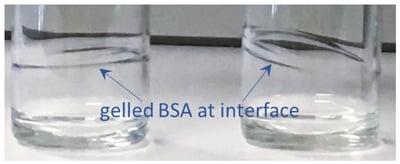Heating a protein beyond a critical temperature can cause it to lose its higher order structures. Molecular unfolding changes the size of the proteins and exposes otherwise hidden functional groups that can be attracted to similar sites on neighboring molecules. In the concentrated regime, this molecular unfolding can result in gelation, making viscosity measurements inappropriate for determining this transition. Even dilute solutions can exhibit local gelation if the proteins are able to migrate to a hydrophobic air interface, which is the case for traditional rotational rheometer or capillary viscometer experiments.

However, the enclosed flow channel in the VROC® Initium prevents the formation of an interface and eliminates the possibility of locally concentrated proteins forming a gel. As a result, viscosity of dilute protein samples can be monitored as function of temperature and the hydrodynamic radius can be estimated from a single concentration intrinsic viscosity analysis. We find that an increase in molecular size with temperature can be indicative of the onset of denaturation or melting.
The increase in the attractive component of the protein-protein interaction (PPI) can lead to aggregate or cluster formation unless a significant repulsive barrier is present to prevent it. The electrostatic repulsion can stabilize proteins when in a charged state. Bovine serum albumin (BSA) is neutral at its isoelectric point (pI~5) and anionic when the pH exceeds the pI (Refs. 1,2). Therefore, increasing the pH beyond the pI should enhance the repulsive barrier leading to a more stable protein solution.
Our new application note is ready for download! As a sequel to our "Can Your Proteins Take the Heat," we have come out with part 2 where we go into further research on how varying pH with dilute proteins at varied temperatures can impact the viscosity. From there, viscosity values can be used to derive the protein to protein interaction and also the melting transition or protein denaturation process.
Download the application note!



